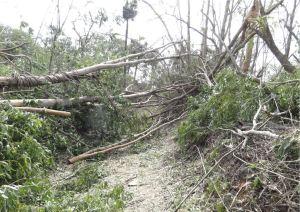 I’ve recently come across an interesting study that perfectly marries palaeo-ecological data with modern conservation philosophy. It’s not often that such a prehistorical perspective dating at least to the Last Glacial Maximum has been used so effectively to inform future conservation outlooks. I’m particularly interested in this sort of approach considering my own palaeo dabblings of late.
I’ve recently come across an interesting study that perfectly marries palaeo-ecological data with modern conservation philosophy. It’s not often that such a prehistorical perspective dating at least to the Last Glacial Maximum has been used so effectively to inform future conservation outlooks. I’m particularly interested in this sort of approach considering my own palaeo dabblings of late.
Published in Nature Communications this May, Lydia Cole and colleagues’ paper Recovery and resilience of tropical forests after disturbance is a meta-analysis of 71 studies covering nearly 300 disturbance events in tropical forests over the last 20,000 years or so. Using fossil pollen records as an index of vegetation change, they demonstrated the (somewhat intuitive) main result that the time to recovery following a disturbance generally decreases as the past disturbance frequency increased.
This appears to be a vindication of the idea that a system’s adaptive strategies evolve as a product of the local disturbance regime. More importantly, they found that recovery was faster following ‘large infrequent events’, which are natural perturbations such as cyclones and major fires. While most past disturbances were caused by humans clearing forest, the fact that tropical forest systems were most resilient to ‘natural’ events means that if we can’t stop human disturbances, at least we can attempt to emulate natural processes to maximise the rebound potential. Much like many modern forestry operations try to emulate natural disturbances to limit their damage, we should at least manage our impacts by understanding so-called ‘natural’ regimes as much as possible.
Across all the disturbance types (including those arising from climate changes), recovery time ranged from as little as 10 years to nearly 7000 years, with a median recovery time of 21o years, and a mean of around 500 years. This appears to agree well with previous studies of tropical biodiversity recovery in tropical forests that Martin & colleagues reported last year. This means that the reported average recovery time of tropical and boreal forests of 42 years is way too low. Clearly, Douglas Adams was also wrong.
Finally, the fact that Cole and colleagues found that the recovery rates recorded following human-induced burning were particularly slow means we should be worried. In many parts of the tropics, the conversion of agricultural areas to forests often uses fire to assist the transition. Given the long-term context (in this case, tens of thousands of years) of this result, perhaps we should reconsider our use of fire in tropical restoration approaches.

